I heard about about a complaint from one of the NASA video engineer who was responsible to tune the cameras for the Pathfinder mission to Mars. The engineer explains that he properly set up the video camera on Earth, meaning mainly that he adjusted the RGB balance so that the images would not be too Red, too Green or too Blue. He was then really sorry to learn that the settings have been changed later, the RED having been exaggerated by 30%. It seems the NASA found the settings incorrect, they would not "reflect the true redishness" of the planet Mars.
This seemed a little strange. I decided to use some of the pictures that the NASA provides to the general public on its web site, and tune it back by lowering 30% of the red component. The first picture I used is the most widely spread, it has been reproduced everywhere since in the press and on the web. It is the "Twin Peaks" picture, named because of the two twin hills.
This is the original picture from the NASA, reduced by myself for quicker download (click on it and you will get the full sized original one:
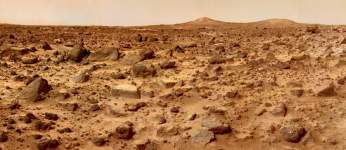
|
I turned the value of the red component down 30%, found it to be a little too green, so I took 6% less green, and increased the light a little bit, because if I take 30% less red and 8% less green, it diminishes the overall lighting. This is the picture that I obtained.
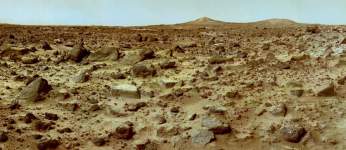
|
I was amazed. Looking at the two pictures, I had the feeling that the one above is wrong. Too red. There is no distinct tone between the ground and the sky. Knowing the red component is increased by 30% by the NASA, it seems obvious that decreasing the red by 30% provides the "real" picture, the one underneath. And this corrected one has distinctive tones. The ground looks like a rocky Saharian desert, with a blue sky above. Perfectly natural, and very earth-like. You can do it yourself to check!
I decided to check whether other ground pictures of Mars show the same effect. I used older picture from the first Viking missions and applied the same treatment.
The two pictures below are also from the Pathfinder mission. You can get the larger versions. These pictures are interesting because you can check the color balance on the white parts of the lander: on the NASA picture, there is a red hue on the whole of these parts. On my "corrected" picture, there is some blue reflection on the parts, but they are overall white, which seems to show that my corrections are accurate: most of the white parts appear white, not red or blue.
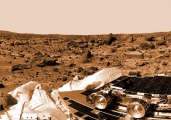
|
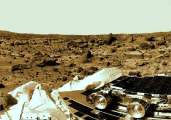
|
These pictures are from the first Viking mission. You can get the larger versions. In this case, is it obvious again than by dimming back the red component, you restore a better picture where not everything is red, instead, you can clearly see a red-brown soil under a sky that has clearly different colors than the soil.
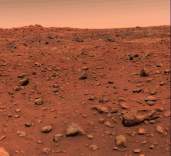
|
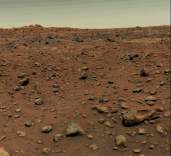
|
Viking mission pictures, Mars at sunset. Look at the larger versions and compare the aspects of the big rock. A blue grey sky reflects as blue grey on Viking on my corrected version. On the NASA original, everything is just red again.
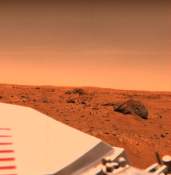
|
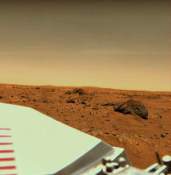
|
I thought it may be possible that NASA also published some non corrected picture, forgetting to enhance the red component on them, and here are some of them. Click them to get the original sized pictures, note that they are quite large and the download time will be significant.
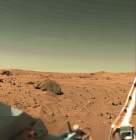
|
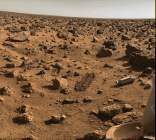
|
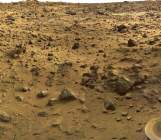
|
Let me insist that I did no correction on these pictures: they look like my corrected pictures because NASA did not change the colors on those.
Are there other signs of image editing on ground pictures of Mars? Here is one example I found, a Viking picture full of anomalies. The fact that the picture is composed of several pictures patches together is only normal. But what about the colorized cable over a grey scale section for example? You can download the full size picture and look at it, you will easily discover many anomalies:
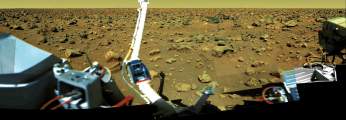
|
Here is one of them for example:
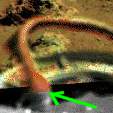
|
NASA processes the pictures with Adobe Photoshop, and ... "The color balance was adjusted to approximate the true color of Mars". As you can read it in this page I found at shuttle.ksc.nasa.gov and included in this site.
My impression is much more that the color balance is almost always adjusted to the color that Mars is supposed to have!
My investigation continues. The addditional evidence of manipulation, and the reason of this manipulation are here.
Recently I was able to find a lot more information and items of interest on this topic:
There is now a debate between NASA photographs and the team who handles the Hubble space telescope. The Hubble team pointed the telescope to Mars and made clear observation that the sky is blue not red or salmon. they informed NASA that their colour for the sky is wrong. So, one more sign that I am right: there is a blue sky on Mars.
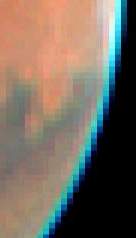
|

|
Above: Hubble pictures of Mars, May 17, 1997:
could the atmosphere be more blue?
One person told me over the Internet that the sky is red on Mars because of the well known storms that carry red dust across the atmosphere.
My answer is:
The storms do not occur permanently. Most of the time there is no storm. When probes are sent to the surface of Mars, the weather conditions are of course studied carefully: no image would be send back during a storm without knwoledge that the picture has be taken during a storm (these storms are predictable, very long, and also stop for long enough periods of time. If a sandstorm had occured for example during the Viking and Pathfinder photo sessions, you would not have the clear sky and perfectly visible landscape shown on the photographs!
If the sky was reddish because of a storm, by decreasing the amount of red, I would not show a blue colour, I would just reduce the reddishness, which means a darker image with both more blue and green.
Also, it is quite reasonable to think that the sky would appear reddish during a storm. But it does not allow to claim that the sky is red. It would be like claiming that the sky of the Earth is grey, because it is grey when there are clouds. Of course it is sometimes grey, but we all agree to define the color of the sky of Earth as blue!
I was delighted to find more and more web sites publishing about the same idea that you can find in this page. Some of them just reproduce pictures from the page with slightly edited text (feel free to), other are obviously from persons who came across the same idea of the wrong color in NASA photos on their own.
Example: "When you correct the images data on Viking 2 using the CO2 ground frost images and the white instrument cover - the sky becomes BLUE. (?)"
While my mailbox is full with appreciative comments about my opinion that the Martian sky is bluer than claimed and the ground not that terrible red, some readers seem to understand that I am colorizing the pictures. No. NASA does, not me.
So here is an additional page with all the references, original pictures links, quotes of NASA, Hubble and JPL personal with the links to ckeck their authenticity.
I did not foresee that my claim that the Martian sky is not red, at least, that the photographs showing a completely reddish planet are strongly exaggerated, would start a flow of email, some thanking me for bringing that topic out, other much more critical. Here are some samples and my answers.
So, before sending objections, please, read the rest of the investigation, with the rest of the argumentation, and the answers I already gave to typical objections.